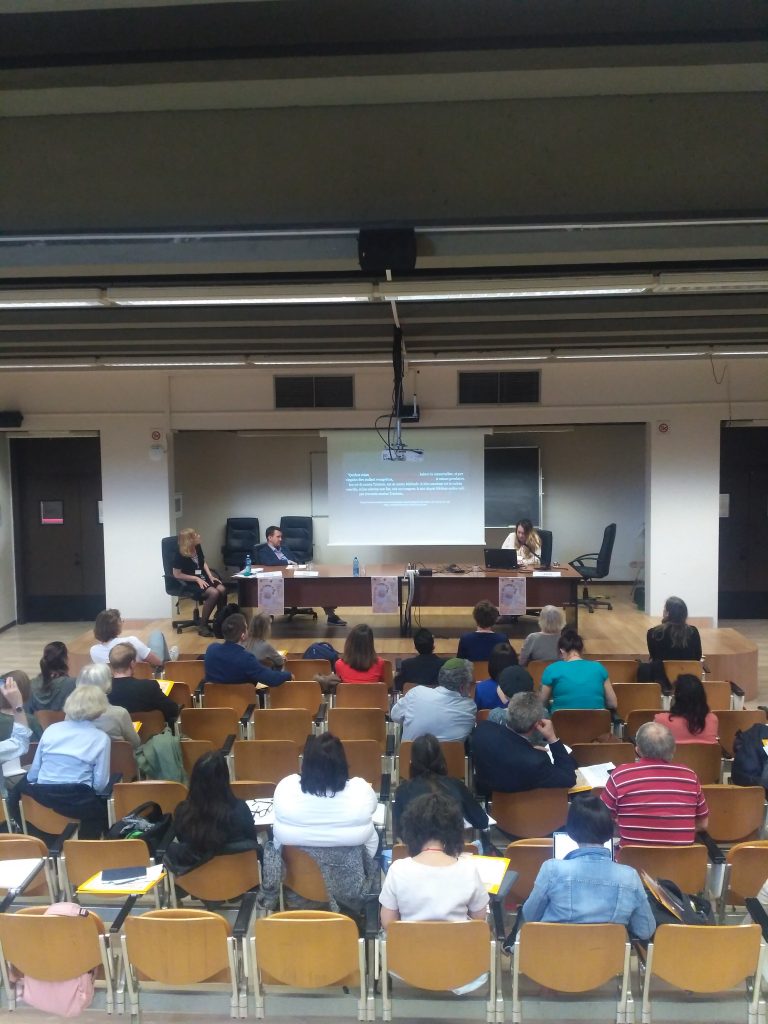At the end of May 2019, the International Society for Folk Narrative Research (ISFNR) committee on “Charms, Charmers and Charming” organised the 12th annual interdisciplinary conference in Pescara, Italy. What was the topic? The language of magic. As this is a subject very important for our project, we decided to participate as well, particularly to hear what other academics have to say on the matter.
The event was hosted by the D’Annunzio University of Chieti–Pescara. Pescara is a coastal city and the capital of the Abruzzo region. The settlement predates the Roman conquest and one of the most important historical figures was the 6th century bishop Cetteus, who is also the city’s patron saint and has a cathedral in the center of town. It was a pity that the conference was held at the end of May and not in full summer, as Pescara–whose name originally meant “abounding with fish”–has beautiful adriatic beaches. On the other hand, the weather was still too cold to tempt the participants to wander off to the beach.
Now, what was discussed at the conference? A wide range of topics – from Hittite magical practices and their psychological implications discussed by Theresa Roth (Philipps-Universität Marburg), Aramaic incantation bowls presented by Dorit Kedar (Freie Universität Berlin) (who argued that they were made by women and not by rabbis, as was previously thought) up until modern powwow practices in the contemporary American Carolinas studied by Jack Montgomery (Western Kentucky University). The majority of presentations, however, focused on textual charms in medieval manuscripts, from Finland, Ireland and Wales. Jacqueline Borsje (University of Amsterdam) talked about expelling nightmares in Saint Patrick’s Confessions, the authority of the charmer’s word-power in Finnish rituals was discussed by Henni Ilomäki (Finnish Literary Society), and Katherine Leach (Harvard University) focused on a vernacular charm from late medieval Wales using the first line of the Latin Bible, In Principio, as a magical formula. Unfortunately, I cannot mention all scholars who participated, as there were more than 40 presenters! Our team was represented by Markéta Preininger Svobodová who gave a paper on Tantalus amulets, an abbreviated version of which was made into a blogpost two weeks ago.

There is much to be studied on charms and magical texts; the form in which they are written, the way in which the texts should be translated, the source of their magical efficacy, the practical use of textual amulets, the materials on which they were written and the tools which were used, and the identity of the people creating them and using them, just to name a few areas of concern.
Several presenters discussed the form in which the texts were written; they could be written in disappearing formations (see the image above), which made what was unwished for disappear, in a circular manner as on Aramaic incantation bowls, or as in classic linear way. Each way of writing has its own function and meaning.
Another topic discussed was the magical function of letters as indecomposable units having an atomic nature and his character of letters might possibly be a source of their magical efficacy, discussed by Maria Pia Ester Cristaldi from Marmara University. A similar idea appears in Plato’s Cratylus, where the author mentions that the true forms of things appear in letters and syllables. Various combination of letters (especially vowels), which cannot be “read” in a conventional way and therefore seem not to make any sense, might have a magical quality of their own.
The contents of the charms were discussed as well; healing spells against various diseases were mentioned, curses, as well as appeals to gods for various purposes.
Surfaces on which charms were written are extremely varied; of course, the traditional ones appear, such as paper, parchment or pottery, but, for example in medieval England, they were also inscribed on various foodstuffs (as apples), stones or on the patient’s body, as Katherine Hindley from Nanyang Technological University explained. The charms could have been written with ink, but also with the patient’s own blood. As Hindley wrote in the abstract of her paper, this creates “a material connection between the text and the patient”.
The way the charms are pronounced also enhances their magical potency. As Giuseppe de Bonis (University ‘L’Orientale’ Naples) showed, incantations represent an oral performance. Some Germanic charms incantations show that whispering or silence while reciting were ‘media’ which made charms effective in these traditions, according to de Bonis. Eleonora Cianci (University of Chieti-Pescara), the organizer of the conference, spoke about possible signs in texts which could help us understand how the charm was supposed to be orally performed. Davor Nikolić from the University of Zagreb was concerned with the questions of sound-content relationship.
Also, the question of who exactly is the charmer communicating with during the ritual is an important one. Siria Kohonen from the University of Helsinki took a unique approach and referred to cognitive processes in the human mind which could explain this phenomenon of communicating with the “supernatural”.
In conclusion, the conference was extremely stimulating as it showed that some magical practices were very similar throughout history: appealing to a supernatural being, saying magical words or writing texts in “magical” ways. The “disappearing-formation” appears in Greek texts from the 2-3rd centuries and in later Coptic texts, but also in late medieval Latin manuscripts.
I would like to thank the organisers again. A note for the speakers mentioned: please, if any of you feel like your topics were misrepresented in this article, reach out to us and we will make corrections.
The committee agreed that for the 13th (a magical number!) annual conference, the academics will meet in June, in Zagreb, Croatia.
The full programme for the 2019 Language of Magic conference can be seen online here.
